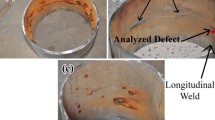Abstract
Pitting of Type 1.4301 stainless steel pipe in a brackish cooling water system was studied. The results showed that pitting of the Type 1.4301 stainless steel occurred when the water temperature was more than 40 °C, and the introduction of Fe2+ or Fe3+ with concentrated chloride ions led to more severe corrosion in this cooling water system.









Similar content being viewed by others
References
M.A.M. Ibrahim, S.S. Abd El Rehim, M.M. Hamza, Corrosion behavior of some austenitic stainless steels in chloride environments. Mater. Chem. Phys. 115, 80–85 (2009)
T. Kekkonen, P. Aaltonen, H. Hänninen, Metallurgical effects on the corrosion resistance of a low temperature sensitized welded AISI Type 1.4301 Stainless Steel. Corros. Sci. 25, 821–836 (1985)
M.J. Jiménez-Come, E. Muñoz, R. García, V. Matres, M.L. Martín, F. Trujillo, I. Turias, Pitting corrosion behaviour of austenitic stainless steel using artificial intelligence techniques. J. Appl. Logic. 10, 291–297 (2012)
B. Maier, G.S. Frankel, Pitting corrosion of bare stainless steel 1.4301 under chloride solution droplets. J. Electrochem. Soc. 157, C302–C312 (2010)
P. Ernst, R.C. Newman, Pit growth studies in stainless steel foils. II. Effect of temperature, chloride concentration and sulphate addition. Corros. Sci. 44, 943–954 (2002)
T. Laitinen, Localized corrosion of stainless steel in chloride, sulfate and thiosulfate containing environments. Corros. Sci. 42, 421–441 (2000)
World Health Organization, Guidelines for Drinking-Water Quality, 4th edn. (WHO Press, Switzerland, 2011)
A.E. Al-Rawajfeh, H. Glade, J. Ulrich, Scaling in multiple-effect distillers: the role of CO2 release. Desalination 182, 209–219 (2005)
V.A. Prisyazhniuk, Prognosticating scale-forming properties of water. Appl. Therm. Eng. 27, 1637–1641 (2007)
J.J. Santana Rodríguez, F.J. Santana Hernández, J.E. González González, Comparative study of the behaviour of AISI 1.4301 SS in a natural seawater hopper, in sterile media and with SRB using electrochemical techniques and SEM. Corros. Sci. 48, 1265–1278 (2006)
Acknowledgments
We are thankful to the China National Petroleum Corporation (CNPC) for the fund support (2012GJTC-01-07-02) of the research.
Author information
Authors and Affiliations
Corresponding author
Rights and permissions
About this article
Cite this article
Guo, C., Li, M., Shen, Q. et al. Failure Analysis of Type 1.4301 Stainless Steel in a Cooling Water System. J Fail. Anal. and Preven. 15, 401–406 (2015). https://doi.org/10.1007/s11668-015-9939-2
Received:
Revised:
Published:
Issue Date:
DOI: https://doi.org/10.1007/s11668-015-9939-2




